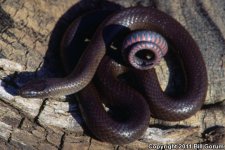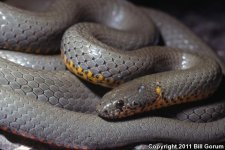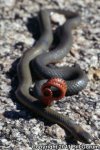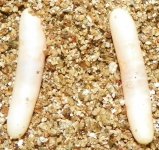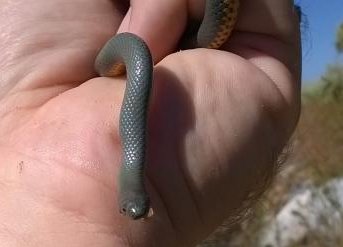| Range: |
 |
| Other Names: |
Red-bellied Snake, Punctated Viper Ring Snake, Ringneck Snake, Western Ring-necked Snake |
| Description: |
An up to 34 inches long gray snake with a ring (commonly absent in this subspecies) of yellowish orange around its neck. The belly is usually the same color as the ring and gets redder toward the tail. The belly has a double or triple row of half-moon shaped black spots. |
| Venom: |
Rear-fanged, not considered dangerous to humans. I have heard annectdotal evidence that the venom is very potent on reptiles. Keepers who have kept both Diadophis punctatus regalis and Micruroides euryxanthus euryxanthus have said that the prey tends to die quicker from a regalis envenomation. |
| Habitat: |
It is found in communities ranging from Mohave Desertscrub and Sonoran Desertscrub into Petran Montane Conifer Forest. This snake is encountered on grassy slopes, bajadas, foothills, canyon bottoms, and low valleys. In the more arid parts of the state it is usually found near drainages, springs, and riparian corridors. |
| Behavior: |
Spend most of their time underground. When agitated, they frequently curl up their tail and expose the red underside. Captured individuals often drool from the corner of the mouth, possibly the result of the secretion of venom. |
| Hibernation: |
Overwintering retreats include burrows of other animals and deep crevices in rock outcrops. |
| Reproduction: |
Mating takes place in spring. A clutch of up to 18 eggs is laid in late spring or early summer. Eggs are long and skinny. |
| Diet: |
Small snakes including Black-headed snakes, lizards and invertebrates. |


